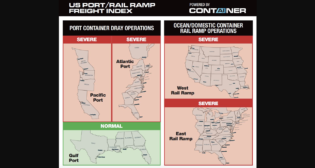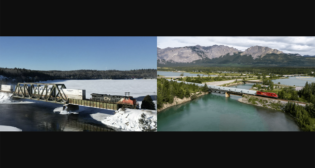
USEIA: CBR tops 50% of supply to East Coast refineries
Written by William C. Vantuono, Editor-in-ChiefThe U.S. Energy Information Administration (EIA) has determined that there has been a “huge increase” in rail deliveries of crude oil to East Coast refineries.
“Monthly rail receipts of crude oil accounted for more than half (52%) of the crude oil supply to East Coast refineries in February,” EIA said. “As U.S. and Canadian production of crude oil has increased, crude supply by rail to East Coast PADD 1 (Petroleum Administration for Defense District 1) refineries has grown, displacing waterborne imports of crude oil from countries other than Canada, such as Nigeria. While refinery utilization in PADD 1 in early 2015 has been below typical levels, this still marks the first time in EIA’s dataset that crude deliveries by rail have accounted for such a high percentage of East Coast refinery supply.”
 “The growth since 2010 in inland domestic and Canadian crude oil production created an opportunity for U.S. and Canadian railroads to move crude oil to U.S. refining centers on the Gulf, East, and West coasts as well as to refineries in Canada,” EIA said. “Much of the crude oil moved by rail is produced from the Bakken Shale in North Dakota and eastern Montana. Bakken crude supplied by rail to U.S. East Coast refineries, along with U.S. crude production supplied by marine vessels from the Gulf Coast, has reduced demand for foreign crude oil at the East Coast refineries. In January 2014, domestic crude oil accounted for half of all East Coast refinery crude oil receipts, and CBR net receipts to the East Coast surpassed non-Canadian crude oil imports.
“The growth since 2010 in inland domestic and Canadian crude oil production created an opportunity for U.S. and Canadian railroads to move crude oil to U.S. refining centers on the Gulf, East, and West coasts as well as to refineries in Canada,” EIA said. “Much of the crude oil moved by rail is produced from the Bakken Shale in North Dakota and eastern Montana. Bakken crude supplied by rail to U.S. East Coast refineries, along with U.S. crude production supplied by marine vessels from the Gulf Coast, has reduced demand for foreign crude oil at the East Coast refineries. In January 2014, domestic crude oil accounted for half of all East Coast refinery crude oil receipts, and CBR net receipts to the East Coast surpassed non-Canadian crude oil imports.
“The growth in CBRl shipments to East Coast refineries has been made possible by expansions in the capacity to load and unload crude oil from trains. Some facilities handle individual railcars or a small number of railcars [in] manifest trains; others are built for unit trains that consist of 80 to 120 railcars carrying crude oil.
“Rail terminals are now better equipped to load and unload unit trains. Five years ago, U.S. rail loading capacity for crude oil was almost entirely for manifest trains, but now more than 30 loading terminals throughout the U.S. can accommodate unit trains. On the East Coast, 10 terminals can unload crude oil unit trains. CBR unloading facilities are located on refinery property and at non-refinery sites with access to additional modes of transportation, including marine and short-distance pipeline, that allow the crude oil to be shipped on to refineries. As more unit train unloading terminals have been added, some volumes that previously transferred to vessels in Albany before moving on to refineries in New York Harbor, the Philadelphia area and Canada now are moved directly by rail closer to their ultimate destinations.”



